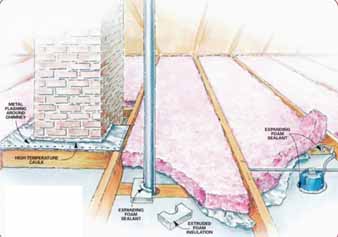
___ A: Attics -- Seat attic bypasses to stop air. Leaks and increase the effectiveness of new or existing insulation.
Insulation—silently hidden in your walls, no moving parts to fix—is a material
you probably spend precious little time thinking about. Then along comes
subzero (or sweltering!) weather, a three-digit utility bill or chilly drafts, and you start thinking about it a lot!
At home, you ponder whether it’s
worth the time and expense to add it to your ceilings, walls and basement.
At the store, you ponder which type, thickness, width and density to buy. and when you install it, you wonder just how good is “good enough.”
We asked insulation manufacturers and installers which questions they field most—and which blunders they see most. Following are six things they (and we) think you should know.
1. Seal up air bypasses before adding attic insulation (or you’ll be wasting money).
Attics are one of the easiest and most cost-effective places to add insulation. But you’ll increase the effectiveness of insulation substantially if you first seal up air bypasses (___ A) around chimneys, plumbing vents, wires, interior walls and exhaust fans—places where warm, moist interior air escapes into the attic.
Heat has a natural inclination to both rise and migrate to colder areas. Combine these two tendencies and you can see why air bypasses can reduce the effectiveness of attic insulation by 30 to 70 percent. You can track down bypasses by lifting existing attic insulation and checking for dark patches of moisture or dust. Or head to the attic on a cold day and feel for pockets of warm air or use a stick of incense to check for drafts.
Before installing (or adding) attic insulation, take these steps:
• Use caulk and expanding foam sealant to close air gaps around pipes, ducts and electrical wires where they enter the attic.
• Cut and fit strips of 24-gauge sheet metal between the masonry chimney and the surrounding wood framing. Use high-temperature caulk to seal the flashing where it meets the chimney.
• Install weather-stripping around the perimeter of the attic access opening, then use screw hooks to pull the hatch tight against the weather-stripping. Glue rigid extruded foam insulation to the top of the hatch.
NOTE: After air-tightening your home, always test your carbon monoxide detectors, or install them if you don’t have them ($20 to $40 at home centers and hard ware stores).
2. Careful installation increases the insulation’s R-value by over 20 percent.
Leaving 5 percent of a wall uninsulated will reduce the entire wall’s R-value (resistance to heat flow) by 20 percent. It doesn’t take much more time to install fiberglass insulation properly (___ B). The most important steps you can take:
• Fill the stud cavity from top to bottom and side to side. To avoid guesswork when insulating walls built from standard 92-5/8-in-long studs, purchase and install precut fiberglass batts that are 93 in. long and 15 in. wide. When you have to custom-cut batts at wall corners and other places, cut the batts 1 in. higher and wider than the cavity you’re filling.
• Split your insulation so half goes in front of and half goes behind electrical wires. Compressing insulation reduces its R-value.
• Around electrical boxes, notch, rather than compress, the batt -- then tuck the cutout behind the box. To help prevent frozen pipes, insulate only on the cold side.
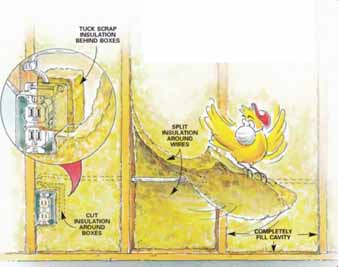
___ B Wall insulation Install wall insulation so it completely
fills each cavity side to side and top to bottom. But remember, packing and compressing insulation reduces its effectiveness. Tuck scrap behind
boxes.
3. You probably don’t need kraft-faced insulation.
Kraft paper—the asphalt-impregnated brown paper facing available on insulation—is rarely called for these days. When insulation was first developed, it was only an inch or two thick and the attached kraft facing was stapled to studs to keep it from sagging. Insulation today is so “full-bodied” and fills stud and joist cavities so completely that it resists settling—even when walls have been purposely vibrated in tests.
Kraft paper does act as a vapor retarder to slow the movement of interior moisture through the wall cavity and insulation. But for a thorough job, especially in bathrooms and other high-moisture areas, a continuous 6-mil plastic sheeting vapor barrier is much more effective. Kraft paper still serves the purpose of temporarily holding insulation in place on horizontal or sloped surfaces. and when you’re retrofitting insulation in the floor of a crawlspace (___ D), installing the kraft-faced insulation paper-side-up provides an adequate vapor retarder. Kraft paper and its underlying asphalt adhesive are flammable and should always be covered with dry-wall or other fire-resistant material.
Another important point: Except in hot coastal regions, insulation should be installed with the kraft paper (or plastic vapor barrier) on the interior side of the wall. In hot regions, vapor barriers are often eliminated or positioned toward the outside of the stud wall. If in doubt, consult a local building inspector.
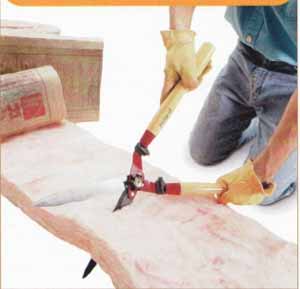
Hint: Insulation trimmer: Here’s a faster,
cleaner way to cut fiberglass insulation. Use a hedge shears to slice
through the insulation. Unlike a utility knife, the shears won’t spread
loose tufts of insulation all over, and the best part is, you stay itch
free.
4. High-density insulation can payoff.
Insulation is rated according to its R-value, or resistance to heat loss: the higher the R-value, the higher the insulating value. Standard fiberglass insulation has an R value of about 3.5 per inch of thickness (___ C); this provides an insulating value of R-11 for 2x4 walls and R-19 for 2x6 walls. But if you’re serious about energy savings, you can buy better-performing products. High- density types of fiberglass insulation, with more fibers and air spaces per square inch, offer R-values of up to 4.25 per inch. Some provide R-15 for 2x4 walls and R-21 for 2x6 walls. There’s also high-density insulation for ceilings and attics. You’ll wind up paying more, and in many cases you’ll need to special-order it, but high-density insulation delivers up to 35 percent more insulating value per inch.
You can also pack 5-1/2-in-thick insulation into a 3-1/2-in-thick wall to increase its R-value, but the compressed R-19 batt will only yield an R-value of about 17.
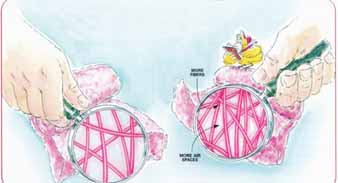
___ C: High-density insulation: The high-density insulation
on the right, with more fibers and air spaces, can deliver up to 35 percent
more insulating value than standard insulation.
5. How much insulation is enough?
The first 3 in. of insulation you add to a bare ceiling or wall will yield huge savings. Adding another 3 in. will increase energy savings, but not to as great a degree. For charts showing the Department of Energy’s optimal amounts of insulation to install, go to www.certainteed.com or www.owenscorning.com. Their recommendations are based on climate, fuel costs and other factors. Adding more will give you a diminishing return on your investment.
The payback period for retrofitting insulation varies greatly, but studies show that added insulation usually pays for itself in saved energy costs within five to 10 years. One typical two-story Minnesota home was fitted with blown-in wall insulation, additional ceiling insulation and rim joist insulation at a cost of $1,890. The result was a $325 savings in yearly heating costs, which represents a payback period of slightly less than six years. Payback in more temperate areas takes longer, but remember that insulation reduces air-conditioning costs too.
6. When you insulate attics and crawlspaces, you’ve got to vent them too.
Since insulation changes the way attics and crawlspaces breathe,” it’s critical that you maintain or install proper ventilation (___ D, below). At first, it seems odd to add insulation for warmth and then purposely create ventilation “holes” for cold air to enter. But if you don’t do this, you’re setting yourself up for moisture problems.
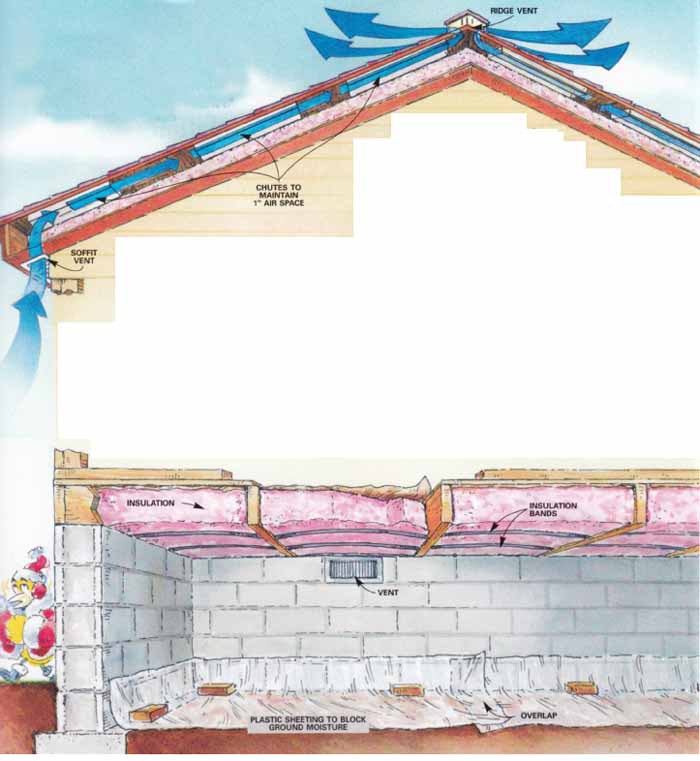
___ D: Attic and crawlspace insulation: venting attics and crawlspaces is critical to reduce moisture problems and allow the
insulation to perform light.
When you add insulation to attic rafters and attic floors, it’s important to maintain at least a 1-in. continuous air space between insulation and roof sheathing, from eaves to ridge. This air space flushes out moisture. It also helps maintain a “cold roof,” which prevents ice dams from forming in the winter and excessive heat from damaging shingles and increasing cooling costs in the summer. The biggest mistake homeowners make with installation is to install it so it blocks the flow of air at the eaves. The best way to avoid this problem is to install inexpensive air chutes to keep the space open. See “Improve Attic Ventilation” presented later.
Newly insulated crawlspaces also need proper ventilation. The standard procedure is to insulate the ceilings of unheated crawlspaces and the walls of heated crawl spaces. To reduce moisture migration if there’s no slab, a 6-mil polyethylene vapor barrier should be laid on the ground in both cases. At least 1 sq. ft. of ventilation should be installed for each 1,500 sq. ft. of floor area.
There are regional differences and various codes and interpretations for insulating crawlspaces and attics. Contact a local building official to make sure your house stays code-compliant.
Next: What is R-value?
Prev: Attics, Crawl Space, Basement, Walls: DIY Home Insulation Guide